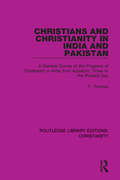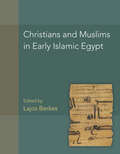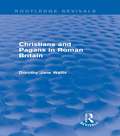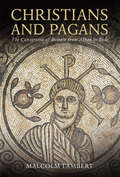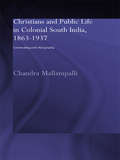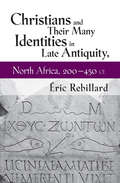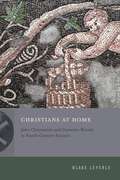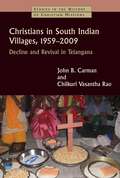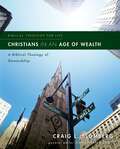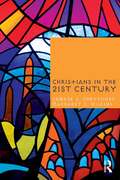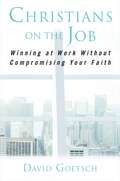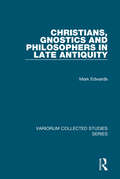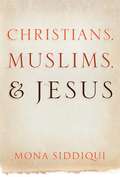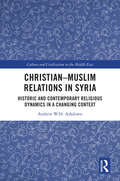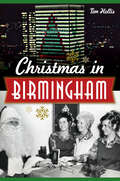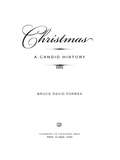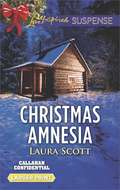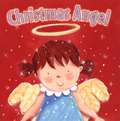- Table View
- List View
Christians and Christianity in India and Pakistan: A General Survey of the Progress of Christianity in India from Apostolic Times to the Present Day
by P. ThomasOriginally published in 1954, Christians and Christianity in India and Pakistan is an historical account of Christianity from the time of Apostle Thomas through to contemporary times. The book records the vicissitudes of the Church prior to the Reformation, the work of the early Protestant missions, and the results of British influence. It provides an overview of Christianity in contemporary India and Pakistan, and explores a range of topics including Indian traditions, the labours of Armenians and the missionaries of the West, the political and social position of Indian Christians, and Christian influences on Hinduism. Christians and Christianity in India and Pakistan will appeal to those with an interest in the history of Christianity.
Christians and Communists: An Ecumenical Perspective
by Ans J Van der BentBack Cover] In this book, Ans J Van der Bent writes a short account "of the critical social issues that shape the encounter between Christians and Communists in the world today, with a particular focus on the sometimes controversial but unavoidable political involvements of the ecumenical movement. Seeking not to provide easy answers but to stimulate thinking about the responsibility of Christians, individually and communally, the author insists that an open and realistic assessment of the resources and failures of both Christianity and Communism is necessary for Christians committed to justice and peace for all the people of the world."
Christians and Muslims in Early Islamic Egypt (American Studies in Papyrology #56)
by Lajos BerkesThis volume collects studies exploring the relationship of Christians and Muslims in everyday life in Early Islamic Egypt (642–10th c.) focusing mainly, but not exclusively on administrative and social history. The contributions concentrate on the papyrological documentation preserved in Greek, Coptic, and Arabic. By doing so, this book transcends traditional disciplinary boundaries and offers results based on a holistic view of the documentary material. The articles of this volume discuss various aspects of change and continuity from Byzantine to Islamic Egypt and offer also the (re)edition of 23 papyrus documents in Greek, Coptic, and Arabic. The authors provide a showcase of recent papyrological research on this under-studied, but dynamically evolving field. After an introduction by the editor of the volume that outlines the most important trends and developments of the period, the first two essays shed light on Egypt as part of the Caliphate. The following six articles, the bulk of the volume, deal with the interaction and involvement of the Egyptian population with the new Muslim administrative apparatus. The last three studies of the volume focus on naming practices and language change.
Christians and Muslims in Early Islamic Egypt (American Studies in Papyrology #56)
by Lajos BerkesThis volume collects studies exploring the relationship of Christians and Muslims in everyday life in Early Islamic Egypt (642–10th c.) focusing mainly, but not exclusively on administrative and social history. The contributions concentrate on the papyrological documentation preserved in Greek, Coptic, and Arabic. By doing so, this book transcends traditional disciplinary boundaries and offers results based on a holistic view of the documentary material. The articles of this volume discuss various aspects of change and continuity from Byzantine to Islamic Egypt and offer also the (re)edition of 23 papyrus documents in Greek, Coptic, and Arabic. The authors provide a showcase of recent papyrological research on this under-studied, but dynamically evolving field. After an introduction by the editor of the volume that outlines the most important trends and developments of the period, the first two essays shed light on Egypt as part of the Caliphate. The following six articles, the bulk of the volume, deal with the interaction and involvement of the Egyptian population with the new Muslim administrative apparatus. The last three studies of the volume focus on naming practices and language change.
Christians and Pagans in Roman Britain (Routledge Revivals)
by Dorothy WattsIn Christians and Pagans in Roman Britain, first published in 1991, Professor Dorothy Watts sets out to distinguish possible Pagan features in Romano-British Christianity in the period leading up to and immediately following the withdrawal of Roman forces in AD 410. Watts argues that British Christianity at the time contained many Pagan influences, suggesting that the former, although it had been present in the British Isles for some two centuries, was not nearly as firmly established as in other parts of the Empire. Building on recent developments in the archaeology of Roman Britain, and utilising a nuanced method for deciphering the significance of objects with ambiguous religious identities, Christians and Pagans in Roman Britain will be of interest to classicists, students of the history of the British Isles, Church historians, and also to those generally interested in the place of Christianity during the twilight of the Western Roman Empire.
Christians and Pagans: The Conversion of Britain from Alban to Bede
by Malcolm LambertChristians and Pagans offers a comprehensive and highly readable account of the coming of Christianity to Britain, its coexistence or conflict with paganism, and its impact on the lives of both indigenous islanders and invading Anglo-Saxons. The Christianity of Roman Britain, so often treated in isolation, is here deftly integrated with the history of the British churches of the Celtic world, and with the histories of Ireland, Iona, and Pictland. Combining chronicle and literary evidence with the fruits of the latest archaeological research, Malcolm Lambert illuminates how the conversion process changed the hearts and minds of early Britain.
Christians and Public Life in Colonial South India, 1863-1937: Contending with Marginality
by Chandra MallampalliThis book tells the story of how Catholic and Protestant Indians have attempted to locate themselves within the evolving Indian nation. Ironically, British rule in India did not privilege Christians, but pushed them to the margins of a predominantly Hindu society. Drawing upon wide-ranging sources, the book first explains how the Indian judiciary's 'official knowledge' isolated Christians from Indian notions of family, caste and nation. It then describes how different varieties and classes of Christians adopted, resisted and reshaped both imperial and nationalist perceptions of their identity. Within a climate of rising communal tension in India, this study finds immediate relevance.
Christians and Their Many Identities in Late Antiquity, North Africa, 200–450 CE
by Éric RebillardFor too long, the study of religious life in Late Antiquity has relied on the premise that Jews, pagans, and Christians were largely discrete groups divided by clear markers of belief, ritual, and social practice. More recently, however, a growing body of scholarship is revealing the degree to which identities in the late Roman world were fluid, blurred by ethnic, social, and gender differences. Christianness, for example, was only one of a plurality of identities available to Christians in this period.In Christians and Their Many Identities in Late Antiquity, North Africa, 200-450 CE, Éric Rebillard explores how Christians in North Africa between the age of Tertullian and the age of Augustine were selective in identifying as Christian, giving salience to their religious identity only intermittently. By shifting the focus from groups to individuals, Rebillard more broadly questions the existence of bounded, stable, and homogeneous groups based on Christianness. In emphasizing that the intermittency of Christianness is structurally consistent in the everyday life of Christians from the end of the second to the middle of the fifth century, this book opens a whole range of new questions for the understanding of a crucial period in the history of Christianity.
Christians at Home: John Chrysostom and Domestic Rituals in Fourth-Century Antioch (Inventing Christianity)
by Blake LeyerleWhat did it mean for ordinary believers to live a Christian life in late antiquity? In Christians at Home, Blake Leyerle explores this question through the writings, teachings, and reception of John Chrysostom—a priest of Antioch who went on to become the bishop of Constantinople in AD 397.Through elaborate spatial and ritual recommendations, Chrysostom advised listeners to turn their houses into churches. Influenced by New Testament descriptions of the Pauline communities, he preached that prayer and chant, scriptural discussion and hospitality, and even domestic furnishings would have a transformational effect on a home’s inhabitants. But as Leyerle shows, Chrysostom’s lay listeners had different views. They were focused not on personal ethical change or on the afterlife but on the immediate, tangible needs of their households. They were committed to Christianity and defended the legitimacy of their views, even citing precedents from scripture in support of their practicesBy reading these perspectives on early Christian life through one another, Leyerle clarifies the points of disagreement between Chrysostom and his lay listeners and, at the same time, highlights their shared understanding. For both the preacher and his congregations, the household formed a vital ritual arena, and lived religion was necessarily rooted in practice. Elegantly written and convincingly argued, this study will appeal to scholars of theology, classics, and the history of Christianity in particular.
Christians in Caesar’s Household: The Emperors’ Slaves in the Makings of Christianity (Inventing Christianity #1)
by Michael Flexsenhar IIIIn this volume, Michael Flexsenhar III advances the argument that imperial slaves and freedpersons in the Roman Empire were essential to early Christians’ self-conception as a distinct people in the Mediterranean and played a multifaceted role in the making of early Christianity.Scholarship in early Christianity has for centuries viewed Roman emperors’ slaves and freedmen as responsible for ushering Christianity onto the world stage, traditionally using Paul’s allusion to "the saints from Caesar’s household" in Philippians 4:22 as a core literary lens. Merging textual and material evidence with diaspora and memory studies, Flexsenhar expands on this narrative to explore new and more nuanced representations of this group, showing how the long-accepted stories of Christian slaves and freepersons in Caesar’s household should not be taken at face value but should instead be understood within the context of Christian myth- and meaning-making. Flexsenhar analyzes textual and material evidence from the first to the sixth century, spanning Roman Asia, the Aegean rim, Gaul, and the coast of North Africa as well as the imperial capital itself. As a result, this book shows how stories of the emperor’s slaves were integral to key developments in the spread of Christianity, generating origin myths in Rome and establishing a shared history and geography there, differentiating and negotiating assimilation with other groups, and expressing commemorative language, ritual acts, and a material culture.With its thoughtful critical readings of literary and material sources and its fresh analysis of the lived experiences of imperial slaves and freedpersons, Christians in Caesar’s Household is indispensable reading for scholars of early Christianity, the origins of religion, and the Roman Empire.
Christians in Caesar’s Household: The Emperors’ Slaves in the Makings of Christianity (Inventing Christianity)
by Michael Flexsenhar IIIIn this volume, Michael Flexsenhar III advances the argument that imperial slaves and freedpersons in the Roman Empire were essential to early Christians’ self-conception as a distinct people in the Mediterranean and played a multifaceted role in the making of early Christianity.Scholarship in early Christianity has for centuries viewed Roman emperors’ slaves and freedmen as responsible for ushering Christianity onto the world stage, traditionally using Paul’s allusion to “the saints from Caesar’s household” in Philippians 4:22 as a core literary lens. Merging textual and material evidence with diaspora and memory studies, Flexsenhar expands on this narrative to explore new and more nuanced representations of this group, showing how the long-accepted stories of Christian slaves and freepersons in Caesar’s household should not be taken at face value but should instead be understood within the context of Christian myth- and meaning-making. Flexsenhar analyzes textual and material evidence from the first to the sixth century, spanning Roman Asia, the Aegean rim, Gaul, and the coast of North Africa as well as the imperial capital itself. As a result, this book shows how stories of the emperor’s slaves were integral to key developments in the spread of Christianity, generating origin myths in Rome and establishing a shared history and geography there, differentiating and negotiating assimilation with other groups, and expressing commemorative language, ritual acts, and a material culture.With its thoughtful critical readings of literary and material sources and its fresh analysis of the lived experiences of imperial slaves and freedpersons, Christians in Caesar’s Household is indispensable reading for scholars of early Christianity, the origins of religion, and the Roman Empire.
Christians in South Indian Villages, 1959-2009: Decline and Revival in Telangana
by John B. Carman Chilkuri Vasantha RaoA discerning study of a slice of modern Indian Christianity and Christian-Hindu encounter This book revisits South Indian Christian communities that were studied in 1959 and written about in Village Christians and Hindu Culture (1968). In 1959 the future of these village congregations was uncertain. Would they grow through conversions or slowly dissolve into the larger Hindu society around them? John Carman and Chilkuri Vasantha Rao’s carefully gathered research fifty years later reveals both the decline of many older congregations and the surprising emergence of new Pentecostal and Baptist churches that emphasize the healing power of Christ. Significantly, the new congregations largely cut across caste lines, including both high castes and outcastes (Dalits). Carman and Vasantha Rao pay particular attention to the social, political, and religious environment of these Indian village Christians, including their adaptation of indigenous Hindu practices into their Christian faith and observances.
Christians in an Age of Wealth: A Biblical Theology of Stewardship (Biblical Theology for Life)
by Craig L. Blomberg Jonathan LundeIn this book, Craig Blomberg addresses the tough questions about the place and purpose of wealth and material possessions in a Christian’s life. He points to the goodness of wealth, as God originally designed it, but also surveys the Bible’s many warnings against making an idol out of money. So are material possessions a blessing for which we should long? And what are the dangers that the use or abuse of material possessions can produce? Blomberg expounds upon how the sharing of goods and possessions is the key safeguard against both greed and covetousness. He expands on the concept of giving generously, even sacrificially, to those who are needier, demonstrating how Christians can participate in God’s original good design for abundance and demonstrate the world-altering gospel of Christ. Is there any one key to keeping possessions in their proper, God-intended perspective? Are there limits on how rich we should become or on how poor we should allow others to get? What does a truly Christian economic system look like? How does the Bible’s teaching on wealth fit into the gospel?
Christians in the Twenty-First Century
by George D. Chryssides Margaret Z. Wilkins'Christians in the Twenty-First Century' examines Christianity as it is understood and practised both by active followers and those who regard themselves as Christian. The book opens with an examination of key Christian concepts - the Bible, the Creeds, the Church and the sacraments - and the major traditions of Roman Catholicism, Eastern Orthodoxy and Protestantism as well as more recent movements. The book continues with an analysis of the challenges presented by the rise of science, new approaches to biblical scholarship, the rise of fundamentalist movements, the ordination of women, secularization, the interfaith movement, and the impact of the electronic revolution.
Christians on the Job: Winning at Work without Compromising Your Faith
by David GoetschIn Matthew 10:16, Christ advised His Apostles to be "wise" and "innocent" as they go out "in the midst of wolves." This book shows Christians how to be wise and innocent as they work among people who sometimes behave like wolves. Temptation, greed, dishonesty, and misguided ambition have always presented challenges for Christians in the workplace. Add secular bias, political correctness, and persecution to the mix, and the modern workplace becomes a foreboding environment for Christians to navigate. This is so much the case, many Christians wonder if it is still possible to earn a living without compromising their faith. Christians on the Job does more than demonstrate that Christians can stand firm when confronted with faith-related dilemmas in the workplace. It also demonstrates how to go about it. Using concepts illustrated with real-life examples, steps to implement in specific situations, life application questions, and resources for going deeper, Dr. Goetsch draws a clear map to ensure Christians can find their way and thrive on the job.
Christians with Courage
by Ruth Johnson JayThe Bible contains stories of many great men and women of God. Hebrews 11 and the Book of Acts review the lives and deeds of several Old and New Testament heroes. All were courageous and bold. Some endured great hardships. Some gave their lives for their faith. Others just consistently served their Lord and Master, spreading the Gospel and trusting His leadership.
Christians, Gnostics and Philosophers in Late Antiquity (Variorum Collected Studies #1014)
by Mark EdwardsGnosticism, Christianity and late antique philosophy are often studied separately; when studied together they are too often conflated. These articles set out to show that we misunderstand all three phenomena if we take either approach. We cannot interpret, or even identify, Christian Gnosticism without Platonic evidence; we may even discover that Gnosticism throws unexpected light on the Platonic imagination. At the same time, if we read writers like Origen simply as Christian Platonists, or bring Christians and philosophers together under the porous umbrella of "monotheism", we ignore fundamental features of both traditions. To grasp what made Christianity distinctive, we must look at the questions asked in the studies here, not merely what Christians appropriated but how it was appropriated. What did the pagan gods mean to a Christian poet of the fifth century? What did Paul quote when he thought he was quoting Greek poetry? What did Socrates mean to the Christians, and can we trust their memories when they appeal to lost fragments of the Presocratics? When pagans accuse the Christians of moral turpitude, do they know more or less about them than we do? What divides Augustine, the disenchanted Platonist, from his Neoplatonic contemporaries? And what God or gods await the Neoplatonist when he dies?
Christians, Muslims and Jesus
by Mona SiddiquiProphet or messiah, the figure of Jesus serves as both the bridge and the barrier between Christianity and Islam. In this accessible and revelatory book, Muslim scholar and popular commentator Mona Siddiqui explores the theological links between the two religions, showing how Islamic thought has approached and responded to Jesus and Christological themes from its earliest days to modern times. The author finds that the philosophical overlap between the two religions is greater than previously imagined, and this being so, her book brings with it the hope of improving interfaith communication and understanding. Through a careful analysis of selected works by major Christian and Muslim theologians during the formative, medieval, and modern periods of both religions, Siddiqui focuses on themes including revelation, prophesy, salvation, redemption, grace, sin, eschatology, law, and love. How did some become the defining characteristics of one faith and not the other? Which--and why--do some translate between the two religions? With a nuanced and carefully considered analysis of critical doctrines of Christianity and Islam, the author provides a refreshing counterpoint to contemporary polemical arguments and makes an important contribution to reasoned interfaith conversation.
Christian–Muslim Relations in Syria: Historic and Contemporary Religious Dynamics in a Changing Context (Culture and Civilization in the Middle East)
by Andrew W. AshdownOffering an authoritative study of the plural religious landscape in modern Syria and of the diverse Christian and Muslim communities that have cohabited the country for centuries, this volume considers a wide range of cultural, religious and political issues that have impacted the interreligious dynamic, putting them in their local and wider context. Combining fieldwork undertaken within government-held areas during the Syrian conflict with critical historical and Christian theological reflection, this research makes a significant contribution to understanding Syria’s diverse religious landscape and the multi-layered expressions of Christian-Muslim relations. It discusses the concept of sectarianism and how communal dynamics are crucial to understanding Syrian society. The complex wider issues that underlie the relationship are examined, including the roles of culture and religious leadership; and it questions whether the analytical concept of sectarianism is adequate to describe the complex communal frameworks in the Middle Eastern context. Finally, the study examines the contributions of contemporary Eastern Christian leaders to interreligious discourse, concluding that the theology and spirituality of Eastern Christianity, inhabiting the same cultural environment as Islam, is uniquely placed to play a major role in interreligious dialogue and in peace-making. The book offers an original contribution to knowledge and understanding of the changing Christian-Muslim dynamic in Syria and the region. It should be a key resource to students, scholars and readers interested in religion, current affairs and the Middle East.
Christimas in Birmingham
by Tim HollisFor decades, the Christmas season in Birmingham was not complete without the sights and sounds of the retail district. During the season, the Magic City made magic with elaborate light displays and the Living Christmas Tree in Woodrow Wilson Park. Many remember the battling Santas of Loveman's and Pizitz, each vying for the hearts of the community. The elaborate Enchanted Forest dazzled shoppers on the sixth floor at Pizitz. In the 1940s, more than 200,000 people lined the streets each year to make merry for the Christmas Carnival parade. Author and local historian Tim Hollis celebrates the happy history of Birmingham's holiday season, reviving the traditions and festivities, the food and shopping of days gone by.
Christlich-Soziale Union: Politisches Kapital und zentrale Herausforderungen der CSU im 21. Jahrhundert
by Martin Sebaldt Gerhard Hopp Benjamin ZeitlerDie CSU steht vor großen Herausforderungen: Die Partei muss Reformen entschlossen anpacken, um dauerhaft zukunftsfähig zu bleiben. Zugleich muss sie ihre bewährten politischen Stärken pflegen und ihren christlich-sozialen, bayerischen Markenkern bewahren. Die Studie unternimmt daher eine umfassende Bestandsaufnahme der Partei, die ihre Stärken und Schwächen systematisch gegeneinander abwägt. Diese Gesamtbilanz bietet dann auch Impulse für Reformmaßnahmen, um die CSU dauerhaft zukunftsfähig zu machen.
Christmaker: A Life of John the Baptist
by James F. McGrathMeet the real John the Baptist. For many, John the Baptist is a footnote in the gospels—Jesus&’s unkempt forerunner. But if we look closer, John emerges as a fascinating and influential religious leader in his own right. Esteemed New Testament scholar James F. McGrath turns his critical eye to overlooked details in Scripture and long-neglected sources to discover who John the Baptist really was. McGrath covers the well-known events of John&’s life, from his miraculous conception to his execution at the hands of Herod Antipas. Along the way, he introduces key context about John&’s social and religious world that fleshes out John&’s character. John becomes a rebel son of a priest. An innovator of ritual. A mentor of Jesus. McGrath also explores John&’s far-reaching impact on the history of religion. Aside from his influence on Christianity, Judaism, and Islam, John is also revered by the Mandaeans, the last extant gnostic sect, who consider themselves John&’s faithful disciples. This fresh look at the life of John the Baptist will fascinate any reader interested in John, Jesus, and their dynamic world.
Christmas
by Bruce David ForbesWritten for everyone who loves and is simultaneously driven crazy by the holiday season, Christmas: A Candid History provides an enlightening, entertaining perspective on how the annual Yuletide celebration got to be what it is today. In a fascinating, concise tour through history, the book tells the story of Christmas--from its pre-Christian roots, through the birth of Jesus, to the holiday's spread across Europe into the Americas and beyond, and to its mind-boggling transformation through modern consumerism. Packed with intriguing stories, based on research into myriad sources, full of insights, the book explores the historical origins of traditions including Santa, the reindeer, gift giving, the Christmas tree, Christmas songs and movies, and more. The book also offers some provocative ideas for reclaiming the joy and meaning of this beloved, yet often frustrating, season amid the pressures of our fast-paced consumer culture. DID YOU KNOW For three centuries Christians did not celebrate Christmas? Puritans in England and New England made Christmas observances illegal? St. Nicholas is an elf in the famous poem "The Night Before Christmas"? President Franklin Roosevelt changed the dateof Thanksgiving in order to lengthen the Christmas shopping season? Coca-Cola helped fashion Santa Claus's look in an advertising campaign?
Christmas Amnesia
by Laura ScottMISTLETOE MEMORY LOSS Assaulted a week before a high-profile drug trafficking trial, assistant district attorney Madison Callahan narrowly escapes death...but suffers amnesia. Now, when she can't recall the identity of her attacker, everyone is suspect-except the handsome policeman who saved her. Officer Noah Sinclair will do anything to bring the mob-connected drug trafficker to justice, including providing personal protection to Madison-the sister of the partner he nearly got killed. But helping her regain her memory may end their unlikely alliance because once she remembers him, Noah might be the last man she'll want to rely on. As the trial looms and with the assailant dead set on ensuring that Madison doesn't survive to see Christmas, it'll take everything Noah's got to keep Madison alive.
Christmas Angel
by Laura DollinFor the littlest readers - a Christmas board book with a twinkly cover. CHRISTMAS ANGEL may be little, but she glistens brightly. Look closely - she's there by the star on the Christmas tree, above each branch and golden light, watching over sleeping children on Christmas Eve. Picture descriptions present.
